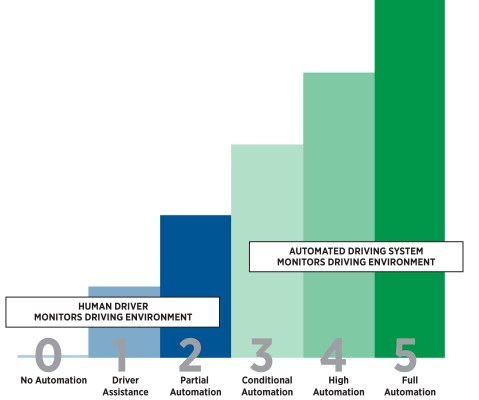When Honda announced that its latest Civic sedan would have a full suite of state-of-the-art driver assist features for $20,000, The Wall Street Journal called it a self-driving vehicle. While the Civic can do a lot, it cannot drive itself. Yet. So what are we even talking about when we talk about autonomous or self-driving vehicles?
Lucky for us, engineers are on top of this. In January 2014, SAE International issued a standard defining exactly what we’re talking about. They gave us six levels, numbered 0-5, and a definition in plain, non-nerd language of what each level means. Here’s a breakdown:
- 0: No automation at all. The human does all the work, even if there are warnings that pop up, like a Check Engine light.
- 1: Driving assistance. The vehicle can assist with steering or speed in certain circumstances, but the human is still fully in charge of driving.
- 2: Partial automation. The vehicle can take over steering and speed altogether in certain circumstances, but the human is still fully in charge of driving.
- 3: Conditional automation. The vehicle steers, takes care of speed and monitors the road. The human is still required to take over when the system needs help.
- 4: High automation. The vehicle can pretty much do everything, even if the human driver does not respond when asked to by the system.
- 5: Full automation. The vehicle does absolutely everything a human driver could do.
Most of the new cars we’re seeing now, in 2016, have level 2 systems available. That includes things like lane keeping and adaptive cruise control — the car can do some steering and speed work, but the driver is still in complete control.
But the more advanced vehicles available have level 3 systems, which are more autonomous. “When you buy a car today, you have the steps toward autonomous driving,” said Paul Rivera, VP of Ricardo, an engineering consulting company, during a panel at the Faraday Future Long Beach ePrix in April. “There are about 35 things that make a car autonomous.”
Looking at the SAE standards, Chris Boroni-Bird of Qualcomm said during the same panel that features of fully autonomous vehicles will be entering the market very soon. Automatic emergency braking, for example, “is autonomous for a few split seconds.”
The goal is to have fully autonomous vehicles, like Google’s self-driving car, completely take over all driving tasks. Google’s test car doesn’t have a steering wheel or pedals; a human cannot take control even if they want to.
There are two basic ways to get to fully autonomous cars: jump in with both feet, which is Google’s strategy, and wade in slowly, which is the major manufacturers’ strategy. Jumping in with both feet requires a small fleet of specially built cars that must go through millions of miles of testing in controlled environments before they’re ready to sell to the public. Wading in means slowly adding to cars being sold proven autonomous technologies as they become available so you can sell cars while ramping up the automation factor.
With companies working both ends of this spectrum, vehicles will only get closer to full autonomy faster. We may not get the flying cars we were promised by science fiction decades ago, but who cares, since we’ll be able to read sci-fi while the car drives us to work.
